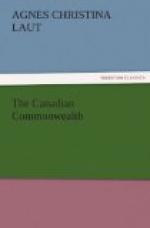Whether heavy subsidies to large liners will effect as much for a merchant marine for Canada as numerous small subsidies to small lines remains to be seen. The development of seamen from her fisheries is one of the dreams she must work out in her destiny, and that leads one to the one great disadvantage under which Canada rests as a marine power. She lacks winter harbors on the Atlantic accessible to her great western domain, whence comes the bulk of her commerce for export. True, the maritime provinces afford those harbors—Saint John and Halifax. A dozen other points, if need were, could be utilized in the maritime provinces as winter harbors; but take a look at the map! The maritime provinces are the longest possible spiral distance from the rest of Canada. They necessitate a rail haul of from two to three thousand miles from the west. What gives Galveston, New Orleans, Baltimore, Buffalo preeminence as harbors? Their nearness to the centers of commerce—their position far inland of the continent, cutting rail haul by half and quarter from the plains. Montreal has this advantage of being far inland; but from November to May Montreal is closed; and Canadian commerce must come out by way of American lines, or pay the long haul down to the maritime provinces. There can be no doubt that this disadvantage is one of the factors forcing the West to find outlet by Hudson Bay—where harbors are also closed by the ice but are only four hundred miles from the wheat plains. There can also be no doubt that the opening of Panama will draw much western commerce to Europe by way of the Pacific.
III
When one comes to consider Quebec under its new boundaries, one is contemplating an empire three times larger than Germany, supporting a population not so large as Berlin.[9] It is the seat of the old French Empire, the land of the idealists who came to propagate the Faith and succeeded in exploring three-quarters of the continent, with canoes pointed ever up-stream in quest of beaver. All the characteristics of the Old Empire are in Quebec to-day. Quebec is French to the core, not in loyalty to republican France, but in loyalty to the religious ideals which the founders brought to the banks of the St. Lawrence three centuries




